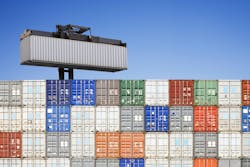Transpacific Trade Shipped to NA Sees Increased Spot Rate
Significant bottlenecks are continuing to occur in Asia for U.S. imports, especially in Southeast Asia, according to ITS Logistics US Port/Rail Ramp Freight Index, that was released on August 19.
For transpacific trade lanes being shipped to North America, the lack of vessel space and container availability continues to increase spot rates by almost 10 times from earlier this year.
The recent closure of Ningbo Beilun's Phase III Terminal due to an explosion on August 9th is also expected to have a significant impact on the main transpacific trade lanes out of Asia as well as the overall supply chain globally.
“This lack of vessel space and container availability is creating the potential for a significant wave of container traffic on the back end of Q3 and early Q4, as more capacity is deployed and rates lower within a range to keep shippers profitable,” said Paul Brashier, vice president of Global Supply Chain for ITS Logistics, in a statement.
There is also concern about a potential 10% tariff on all imported goods with a 60% tax on all good from China that former President Trump said he would propose if elected. The report notes that 15% of all U.S good are imported from China.
“To avoid a similar situation to Q4 2018, some shippers may increase inventory in the back half of 2024, especially if transpacific trade lane shipping rates decrease,” continued Brashier. “Shippers may also want to get ahead of increased consumer demand, which could be influenced by potential interest rate cuts by the Federal Reserve. Perception usually drives reality in shipping, and just the potential of changes in the economy can shift freight activity.”
This month’s forecast also reveals that potential strike activity will affect the West Coast and inland rail legs of ocean container traffic entering Canada. Due to last week’s ruling by the Canada Industrial Relations Board (CIRB), rail is not an essential service in Canada, and a strike or disruption is more likely to occur. As a result, the West Coast ocean region has been categorized as a severe concern, and inland rail ramps are an elevated concern.
Lastly, an increase in revenue per outbound containers is causing them to be expedited back to Asia, which is starting to adversely affect exports. In response, ITS is urging exporters to be cautious as they navigate making cuts for export.
